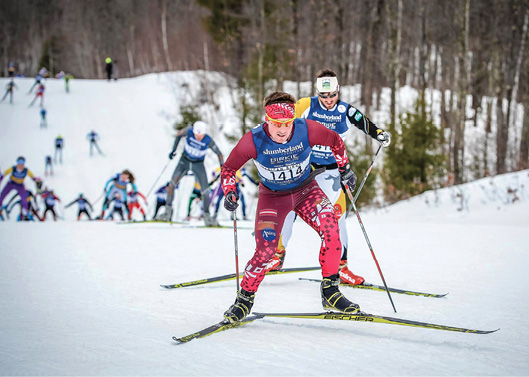
SKIING HISTORY
Editor Kathleen James
Art Director Edna Baker
Contributing Editor Greg Ditrinco
ISHA Website Editor Seth Masia
Editorial Board
Seth Masia, John Allen, Andy Bigford, John Caldwell, Jeremy Davis, Kirby Gilbert, Paul Hooge, Jeff Leich, Bob Soden, Ingrid Wicken
Founding Editors
Morten Lund, Glenn Parkinson
To preserve skiing history and to increase awareness of the sport’s heritage
ISHA Founder
Mason Beekley, 1927–2001
ISHA Board of Directors
Seth Masia, President
Wini Jones, Vice President
Jeff Blumenfeld, Vice President
John McMurtry, Vice President
Chan Morgan, Treasurer
Einar Sunde, Secretary
Richard Allen, Skip Beitzel, Michael Calderone, Christin Cooper, Art Currier, Dick Cutler, Chris Diamond, Mike Hundert, David Ingemie, Rick Moulton, Wilbur Rice, Charles Sanders, Bob Soden (Canada), Betty Tung
Presidential Circle
Christin Cooper, Billy Kidd, Jean-Claude Killy, Bode Miller, Doug Pfeiffer, Penny Pitou, Nancy Greene Raine
Business & Events Manager
Kathe Dillmann
P.O. Box 1064
Manchester Center VT 05255
(802) 362-1667
kathe@skiinghistory.org
Membership Services
Laurie Glover
(802) 375-1105
laurie@skiinghistory.org
Corporate Sponsorships
Peter Kirkpatrick
(541) 944-3095
peterk10950@gmail.com
Bimonthly journal and official publication of the International Skiing History Association (ISHA)
Partners: U.S. Ski and Snowboard Hall of Fame | Canadian Ski Museum and Hall of Fame
Alf Engen Ski Museum | North American Snowsports Journalists Association | Swiss Academic Ski Club
Skiing History (USPS No. 16-201, ISSN: 23293659) is published bimonthly by the International Skiing History Association, P.O. Box 1064, Manchester Center, VT 05255.
Periodicals postage paid at Manchester Center, VT and at additional mailing offices. Postmaster: Send address changes to ISHA, P.O. Box 1064, Manchester Center, VT 05255
ISHA is a 501(c)(3) public charity. EIN: 06-1347398
Written permission from the editor is required to reproduce, in any manner, the contents of Skiing History, either in full or in part.
Short Turns: Alf Engen's Sun Valley days, FIS bans fluorinated wax
FIS Bans Fluorinated Waxes
By Greg DiTrinco
The FIS ban on fluorinated waxes for the 2020–2021 season applies to all ski and snowboard disciplines, but will be especially relevant in nordic competitions, such as the American Birkebeiner. Racers can shave off minutes in a typical 50k race with the advanced wax.
The International Ski Federation (FIS) surprised some ski-race insiders by calling for a ban on the use of all fluorinated ski waxes for next season. The announcement, made at the Federation’s annual fall meeting in Constance, Germany, will catalyze changes in race ski-prep procedures and technology.
“The use of fluorinated ski waxes, which have been shown to have a negative environmental and health impact, were banned for all FIS disciplines from the 2020–2021 season,” according to a FIS press statement released in November 2019. A working group will be formed to establish the new regulations.
The ban originated from the Committee for Competition Equipment, a panel that defines the technical specifications used across the FIS snow sports spectrum: alpine, cross-country skiing, nordic combined, ski jumping, snowboard, freestyle and freeski. The new working group has a rugged road ahead to unite a diverse array of nations and competitive disciplines to agree upon compliance standards.
The Norwegian Ski Federation banned the use of “fluoros” for all racers U16 and under last season, which was used as a test case by FIS to determine if a widespread ban was feasible, according to Ski Racing. Apparently, the answer was yes.
Fluorinated waxes significantly decrease friction and increase glide, and can be used across all ski and snowboard disciplines. As with all bans involving athletic performance or equipment, the success of a prohibition greatly depends on the ability to enforce the ban in the field and reliably test for non-compliance.
The waxes contain perfluoroalkyl and polyfluoroalkyl substances, collectively known as PFAS, which have been linked to a growing list of health concerns. The chemicals are found in drinking water and persistently remain in the food chain. Sometimes called “forever chemicals,” PFAS are resistant to moisture and extremely slow to break down. These are the same qualities that make them so effective in ski waxes.
From pine tar to fluorocarbons, waxing to win has been a constant in ski competitions. Ski waxing, however, long predates alpine skiing. It arose in the early days of Scandinavian ski-sport, from the coincidence that waterproofing wood also helps it to glide on snow. Whether you’re building a ship or a ski, you need to apply a preservative to wood. The earliest known preservative was pine tar, often called pitch.
Waxing evolved along with ski gear. Cross country racer Peter Østbye, born near Lillehammer in 1888, patented Østbyes Klister in 1913. By 1940, a rub-on alpine wax called 1-3-5 was sold under the brand Toko. In 1946, a company was founded under the name of Swix, a blend of the words ski and wax. Swix offered hard and soft waxes to cover a range of snow conditions, providing both glide and durability. Beginning in 1986, Terry Hertel in California and Swix chemists in Norway independently discovered that adding fluorocarbon to wax increased glide by two percent, which can determine the margin of victory in a race. Hertel introduced a commercial version in 1986; Swix followed in 1990, with a fluorocarbon powder that sold for $100 for three grams.
The growing use of fluorinated waxes came with increased scrutiny. Recent studies and subsequent publicity apparently accelerated the push for the ban. In 2016 Congress amended the Toxic Substances Control Act, requiring the U.S. Environmental Protection Agency to control chemicals deemed harmful to human health. As one result, starting in early 2018 the EPA notified all companies using fluorocarbons in their products to document the specific chemicals and amounts used. For ski wax manufacturers and importers this would mean reporting all chemicals – dyes, scents, waxes, hardeners and fluorines, retroactively. Most wax companies couldn’t afford the complex procedures and many immediately stopped selling and making fluorowaxes. Besides, the most common fluorines will be banned in the EU starting in July 2020. It was in this context that FIS imposed the new ban.
For more information on the history of ski wax, see “Grip and Glide” by Seth Masia in the June 2010 issue of Skiing History, or read a variation of his article online: skiinghistory.org/
history/grip-and-glide-short-history-ski-wax
Alf Engen’s Idaho Roots
Alf Engen was one of the best—and best known—skiers in the United States during the 1930s and 1940s, and won more championships, awards and honors than any other competitor in both nordic and alpine disciplines. Though he is closely associated with Utah, he played a significant role at Sun Valley in the resort’s early years.
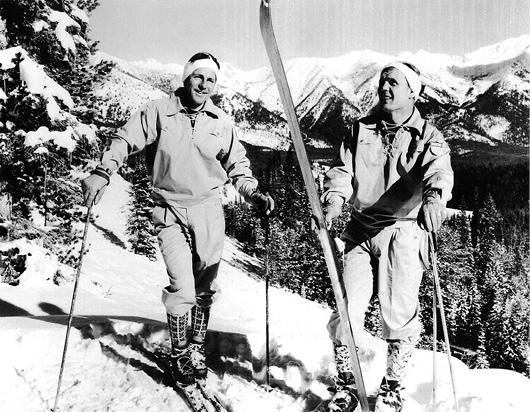
Alf’s first connection with Sun Valley was in early 1936, when he met Count Felix Schaffgotsch, who was sent by Averell Harriman to find the perfect location for Union Pacific’s new ski resort. Alf was the U.S. Forest Service Recreational Supervisor in Salt Lake City, in charge of locating and planning winter sports areas in Utah, Idaho, Nevada and Wyoming, at a time when New Deal programs were providing substantial assistance to the fledgling ski industry. Engen took Schaffgotsch to inspect Alta and Brighton. Schaffgotsch toured six states in six weeks, rejecting many areas that later become successful ski resorts—either their snow conditions or locations were unacceptable—before concluding the area around Ketchum, Idaho, had the perfect combination of snow, weather and hills.
The Forest Service sent Alf to visit Ketchum in winter 1936, when Sun Valley was being built. He met Harriman, who gave him a tour of the area, beginning a long friendship. In spring 1937, Alf and Sigmund Ruud located a site for and designed a ski jump at Sun Valley so Harriman could hold four-way competitions, and Ruud Mountain became the center for ski jumping and slalom events. Alf and Evelyn spent their honeymoon at Sun Valley in December 1937, at Harriman’s invitation.
Harriman hired Engen as a sports consultant and Superintendent of Recreational Facilities at Sun Valley, which included representing Sun Valley in skiing competitions, a role that brought substantial publicity to the resort. In 1938, Alf directed CCC crews that cut a downhill course on Bald Mountain, designed for the Harriman Cup by Dick Durrance. In 1939, his crews cut ski runs on Baldy and chairlifts were installed there for the 1939–1940 season.
Alf competed for Sun Valley virtually his entire amateur career, from 1937 to 1948. He battled fellow Norwegians in widely publicized jumping tournaments all over the country, including Birger and Sigmund Ruud, Torger Tokle, Reidar Andersen, and Olav and Sigurd Ulland, winning honors and setting several national distance records. Alf perfected his alpine skiing at Sun Valley, and led the country’s transition from nordic to alpine skiing, becoming the national four-way and open slalom-downhill combined champion.
Alf helped to coach the U.S. women’s national ski team at Sun Valley in 1939, who were training for the 1940 F.I.S. and Olympic Games (that were cancelled). U.S. Alpine teams for the 1948 Olympic Games at St. Moritz, Switzerland, were selected at Sun Valley. Alf coached prospective Olympians from the Sun Valley Ski Club before the tryouts, and he and Walter Prager, Dartmouth College’s famous coach from Switzerland, were co-coaches of the 1948 U.S. Olympic Team. Alf assisted Gretchen Fraser in her dominating performance at the 1948 Games, where she won gold and silver medals, the first American to win any Olympic skiing medal.
Alf, Evelyn and their son Alan moved to Utah after the Olympics, where he took over the Alta Ski School from his brother Sverre in 1949, directing it until 1989. Alf was inducted into the U.S. Ski and Snowboard Hall of Fame in 1959, joined by his brothers Sverre (1971), Karre (Corey) (1973), and his son Alan (2004), becoming the only family with four members in the Hall.
Alf loved Sun Valley, calling it in his 1986 oral history a “great mountain … difficult to beat.” —John Lundin
On March 25, John Lundin will deliver the first John Fry Legacy Lecture following ISHA’s opening reception during Skiing History Week 2020. The topic is “Sun Valley’s Early Days: Union Pacific, Averell Harriman and Alf Engen.”
Skiing History Day: Mad River Glen
On February 28, we woke up to a foot of new snow at historic Mad River Glen, Vermont — a perfect way to welcome guests to Skiing History Day 2020. A collaboration between the resort and the International Skiing History Association (ISHA), the event drew more than 100 people for skiing, history talks and artifacts, contests and camaraderie.
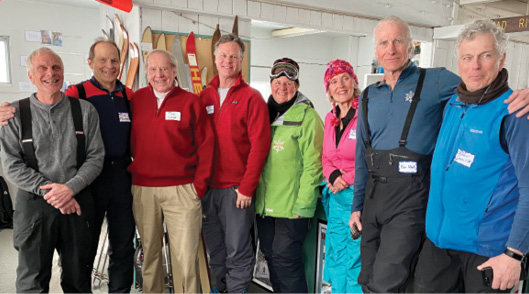
The day kicked off with a presentation on Vermont ski pioneer Roland Palmedo and the 1948 founding of Mad River Glen by Rick Moulton (ski historian and filmmaker), Dr. John Allen (Skiing History contributor, author and New England Ski Museum board member), and John Schultz (longtime Mad River Glen skier and a founder of the Green Mountain Valley ski academy). Austrian ski legend Dixi Nohl (see article, page 16) entertained the crowd with memories from the ‘70s, when he ran Mad River’s ski school for some 10 years, joined by several of his instructors.
Trail guides led group mountain tours throughout the day, and all skiers who successfully completed the resurrected “No Stop, No Fall” challenge—a non-stop, no-wipeout descent from the summit—received an elegant antique pin. Rick Hopkins and Luke Prescott, Mad River patrollers for the last 40 decades, skied alongside to verify the successful “No Stop, No Fall” run. Meanwhile, winners of the vintage skiwear contest were awarded a free one-year membership to the Vermont Ski Museum.
Attendees included ISHA director Rick Moulton and his wife, Melinda (event co-producers); representatives from the Vermont Ski Museum and New England Ski Museum; and dozens of ISHA members and Mad River Glen stalwarts. One of the day’s highlights was the revelation that ISHA member Christopher Sweet of North Attleboro, Massachusetts had not skied Mad River in fifty years—he was eleven years old the last time he went up its iconic single chair. Sweet returned for this event and had a stellar day in the deep natural snow, promising to be back soon. —Melinda Moulton (photos by Melinda Moulton and Kim Holtan)
Sun Valley Skier Shares Rare Bibliographic Find

In 1979, 18-year-old Marc Corney did his best to become a Sun Valley ski bum. He left his Southern California home of Glendora with high hopes of joblessness, raucous nightlife, and endless days of skiing Baldy Mountain. He had some early success but eventually succumbed to responsibility and regular employment. He even went back to school, became an architect, and now has a family. Though a failed ski bum, Marc still skis more than 60 days a year and works as a guest services supervisor. Over the years, he’s developed an appreciation for Sun Valley history and its traditions of mountain camaraderie.
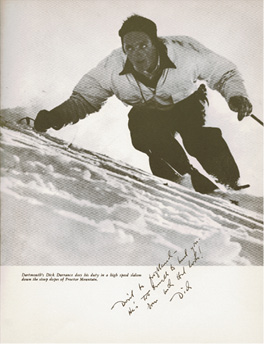
In a Vermont bookshop, Marc came across something unique. The Sun Valley Ski Book, a 1939 pictorial ski instruction tome by Friedl Pfeifer, is not uncommon among collectors and aficionados, but this copy had buried treasure. Along with Pfeifer’s step-by-step instruction and mountain lifestyle photos, there are hand-written captions from photo subjects and a four-page signature spread. Also tucked in are a few vintage newspaper clippings and a song lyric by poet Christopher La Farge, a friend of Ernest Hemingway.
Marc snapped up the souvenir and with his wife, Jill, put the probable story together. The book most likely belonged to Pfeifer and his wife, and was passed around at parties around the time of their wedding in the spring of 1940. The captions are directed to the Pfeifers and the signatures are those of the inner circle of accomplished skiers in Sun Valley’s magical formative years. Every time Marc and Jill open the book, they know they are holding traces of ski heroes in their hands, and they are pleased to share a look with Skiing History readers. We’ll be posting images at our website soon, for ISHA members only, at skiinghistory.org. —David Butterfield


Snapshots in Time
1924 A PRIZE OF DUBIOUS VALUE
Thor Groswold borrowed money for a train ticket and traveled to Dillon, Colorado to compete in a meet. The jumpers had to be sure to clear the knoll and get onto the landing hill, as they had never removed the stumps and rocks below the takeoff. It was very windy during the meet, and both Thor and then-national champion Lars Haugen were blown over and fell. At the Sunday evening banquet, he was given his prize—a crate of eggs. When he questioned the prize, he was told to stop by the general store, where they bought back the eggs for enough money to pay his train fare home. —Jerry Groswold, “Thor Groswold: One of Skiing’s First Great Salesmen” (Collected Papers of the
International Ski History Congress, 2002)
1936 HEY, SISSIES! YOU’RE SCARING THE MOTHERS!
The first death on the slopes shook up the small skiing fraternity of the day. An emergency meeting was called by the New York Amateur Ski Club, whose founder, Roland Palmedo, appointed Minot “Minnie” Dole chair of a committee to inquire into the causes and handling of ski accidents. The results of their questionnaires were disappointing. Only a hundred replies dribbled in. Of these, roughly half accused the committee of being “sissies, spoilsports, and frighteners of mothers.” —Gretchen Rous Besser, “Samaritans of the Snow” (Collected Papers of the International Ski History Congress, 2002)
1959 IVY LEAGUE ANTI-STYLE
If Dartmouth or Harvard types are your heart’s desire, you must spurn current fashions like a plague. Requirements are a pair of well-worn dungarees (preferably patched and faded) pulled over a bulky union suit. This should be topped by an olive drab Army surplus parka, preferably of genuine Camp Hale vintage. Box-toed boots is overdoing it a little bit, but don’t hesitate to resort to them. —Eleanor Prager, “The Happy Hunting Ground: Ski Resorts Are Heaven for Women” (SKI, October 1959)
1967 NEW GIRL IN TOWN
The series of nestling alpine towns and ski runs that tycoon Bill Janss is going to put into the mountains behind Aspen, Colorado, will make Snowmass the biggest, most sought-after and possibly the most beautiful of all the ski complexes of this country. She will debut this year with only some of her envisioned charms available, but even at that, Snowmass will be the new place to ski this winter. Snowmass will have Stein Eriksen in the role of ski school hero, but the star will be the magnificent, marvelous, enchanting, rolling snowland — terrain previously only reachable by ski plane or over-snow vehicle. This winter, Snowmass will have five double chairs, 3,500 feet of vertical, and 50 miles of trails. —(SKI, September 1967)
1974 SKIER’S CODE OF ETHICS
It is immoral to ski unsafely, and unmannerly to ski impolitely. These two ideas shade into each other. The unmannerly skier is also likely to be the immoral skier who skis out of control. For example, too many skiers do not take seriously the duty of staying clear of skiers below. They feel they have the right to yell “Track!” and to whiz by. They do not have that right! We would like to see the Ski Patrol rescind the ticket of every skier who fails to stay clear or who skis so as to endanger the skier below him. —Ski Safety and Courtesy (SKI Magazine Encyclopedia of Skiing)
1978 11 HOURS IN HELL
At 3:45 pm on April 15, 40 people caught the last tram of the day from High Camp at Squaw Valley. Less than 150 feet from Tower 2, something caused the car to derail from the outside cable, suddenly doubling the inside cable’s load. The tram dropped 75 feet and bounced like a yo-yo. When everything had stopped moving, the car had opened up like a burst tin can, hanging 80 feet in the air. Three were killed almost instantly, and most of the 37 survivors were injured, several seriously. —“11 Hours in Hell” by Dick Dorworth (SKI, September 1978)
1995 TEACH YOUR PARENTS WELL
I was unprepared when my son, Andrew, appeared at my shoulder one day of his eighth year. “Uh, Dad?” he said, scraping his thumbnail across the ski edges I’d just spent half an hour sharpening. “Do you think I could go snowboarding with Wyatt today?” “Snowboarding?” I repeated in a voice that betrayed my disgust. Andrew was born to be a skier! “No,” I said. “Why not?” he inquired. I quickly listed a dozen excellent reasons: Snowboarders have weird hair and pierced noses. They sport tattoos. They wear rude stickers. But after much debate, I gave in, certain that a dozen jarring falls would surely discourage him. They didn’t. —Andrew Slough (SKI, February 1995)
SIA Alumni Breakfast
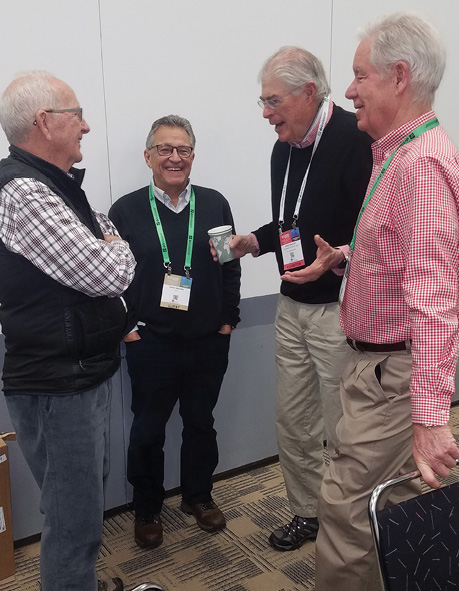 About 30 ski business veterans turned out for the annual alumni breakfast during the annual Outdoor Retailer + Snow Show in Denver on January 31. Here, John Stahler (second from right, Head, Tecnica) entertains Denny Hanson (Hanson, Apex), David Ingemie (SIA, ISHA, U.S. Ski and Snowboard Hall of Fame) and David Scott (Head, Chivers, Lacroix, Nevica). Seth Masia photo.
About 30 ski business veterans turned out for the annual alumni breakfast during the annual Outdoor Retailer + Snow Show in Denver on January 31. Here, John Stahler (second from right, Head, Tecnica) entertains Denny Hanson (Hanson, Apex), David Ingemie (SIA, ISHA, U.S. Ski and Snowboard Hall of Fame) and David Scott (Head, Chivers, Lacroix, Nevica). Seth Masia photo.
Ski History Calendar
April 16–26 World Ski and Snowboard Festival 2020
Whistler, B.C.
Claiming to be the largest celebration on snow, the World Ski and Snowboard Festival celebrates Whistler’s mountain culture with ten days of late-spring shenanigans. On the mountain, there are ski and snowboard competitions and demonstrations, including the 18th edition of the Saudan Couloir Ski Race Extreme. Named after the legendary Swiss “Skier of the Impossible” Sylvain Saudan, the competition is touted as the steepest ski race on the planet. Back on flat ground, art, filmmaking, photography, music and other events fill up the village for the festival’s raucous run.
May 4–7 NSAA National Convention and Tradeshow
Omni Amelia Island Plantation Resort, Florida
The National Ski Areas Association brings together the major influencers in the resort industry for its annual post-season convention and industry mixer. Keynote speakers include Afdhel Aziz, the author of Good is the New Cool: Market Like You Give a Damn, which explores how businesses can be a force for positive social impact and attract customers from the new generation of socially aware consumers. Educational sessions will address a wide range of topics, from the influence of digital lodging platforms, such as VRBO, to the growing importance of resort branding in today’s world of ski-area consolidation.
June 24–July 3 Aspen Ideas
Festival Aspen, Colorado
Featuring boldface names from around the world, the Aspen Ideas Festival is one of the nation’s premier public festivals featuring leaders, policy makers and business disruptors who explore ideas that both shape our lives and challenge our times. The festival is public and open to all. Topics have included Redefining Capitalism, Planet in Peril, Finding Beauty and the American Idea.


Table of Contents
2020 Corporate Sponsors
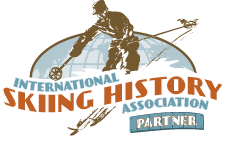
World Championship
($3,000 and up)
Alyeska Resort
Gorsuch
Intuition Sports, Inc.
Obermeyer
Polartec
Warren and Laurie Miller
Snowsports Merchandising Corporation
World Cup ($1,000)
Active Interest Media | SKI & Skiing
Aspen Skiing Company
BEWI Productions
Bogner
Boyne Resorts
Country Ski & Sport
Dale of Norway
Darn Tough Vermont
Descente North America
Dynastar | Lange | Look
Fairbank Group: Bromley, Cranmore, Jiminy Peak
Fera International
Gordini USA Inc. | Kombi LTD
HEAD Wintersports
Hickory & Tweed Ski Shop
Mammoth Mountain
Marker-Völkl USA
National Ski Areas Association (NSAA)
Outdoor Retailer
POWDR Adventure Lifestyle Corp.
Rossignol
Ski Area Management
Sun Valley Resort
Vintage Ski World
World Cup Supply, Inc.
Gold ($700)
Race Place | BEAST Tuning Tools
The Ski Company (Rochester, NY)
Thule
Silver ($500)
Alta Ski Area
Clic Goggles
Dalbello Sports
Deer Valley
Ecosign Mountain Resort Planners
Hertel Ski Wax
Holiday Valley
Hotronic USA, Inc. | Wintersteiger
MasterFit Enterprises
Metropolitan New York Ski Council
Mt. Bachelor
NILS, Inc.
Portland Woolen Mills
Russell Mace Vacation Homes
Schoeller Textile USA
Scott Sports
Seirus Innovations
SeniorsSkiing.com
Ski Utah
Snow Time, Inc.
Sports Specialists, LTD
SympaTex
Tecnica Group USA
Timberline Lodge & Ski Area
Trapp Family Lodge
Vuarnet
Western Winter Sports Reps Association
World Pro Ski Tour
For information, contact: Peter Kirkpatrick | 541.944.3095 | peterk10950@gmail.com
ISHA deeply appreciates your generous support!

